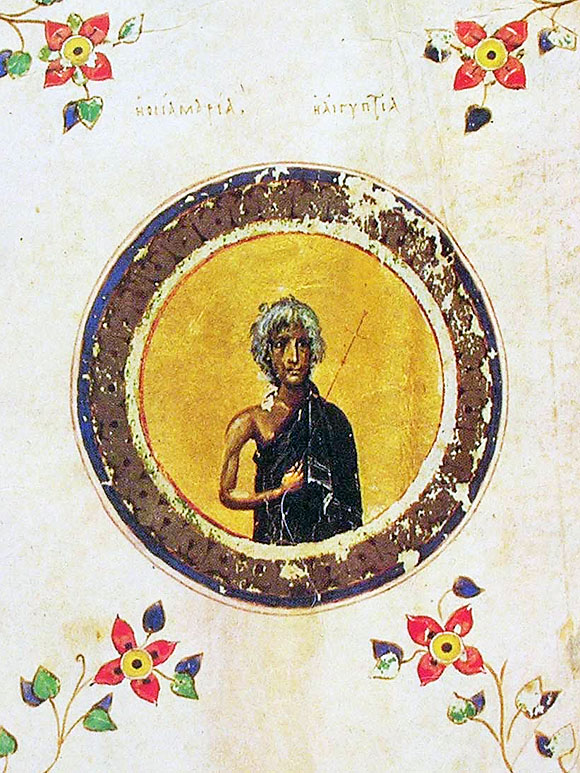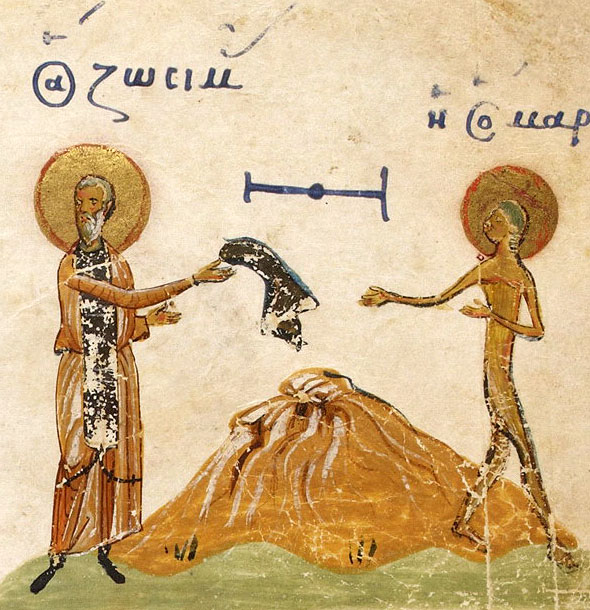Saint Mary of Egypt (Fr. Michael Gillis)
1 Απριλίου 2017
In the Holy Orthodox Church on the fifth week of Great Lent we read the life of St. Mary of Egypt: out loud, as part of compline.

St. Mary is a repentant harlot who lived as a hermit for forty-seven years in the wilderness east of the Jordan River in the early sixth century. Near the end of her life, she is found by a certain monk from the monastery of St. John the Baptist, Fr. Zosimas, to whom she tells her story.
In the normal course of the liturgical life of the Church, the Synaxarion (book of the lives of the Saints) is read every day at Matins. For Orthodox Christians the lives of the saints function not only as lesson in holiness, morality or zeal, but most importantly as evidence. The saints are evidence that men and women can indeed be holy, we can indeed participate in the very Life of God. And in the Church, we tell these stories again and again because we fall into weakness and doubt so easily.
Saints come in all shapes and sizes, you might say. There is not just one way to become a saint. Some saints have been killed or tortured for their faith. Others have lived lives of stillness and prayer. Others have lived lives of service and love. Each woman or man must follow the path of holiness laid down before him or her. In fact, the Orthodox Church does not even have an official process by which one is recognized and canonized as a saint. Sanctity is recognized and venerated by the people and eventually officially recognized by the bishops. Often saints are local, known only by the people in the area where the saint lived. Other saints so encourage the faithful that they are well known the world over.
St. Mary of Egypt is one of the best known saints in the Orthodox Church. She is an Alexandrian woman who lived from age twelve to twenty-nine as a harlot, not out of necessity but out of desire: «I was like a fire of public debauch. And it was not for the sake of gain—here I speak the pure truth. Often when they wished to pay me, I refused the money. I acted in this way so as to make as many men as possible to try to obtain me, doing free of charge what gave me pleasure. Do not think that I was rich and that was the reason why I did not take money. I lived by begging, often by spinning flax, but I had an insatiable desire and an irrepressible passion for lying in filth. This was life to me. Every kind of abuse of nature I regarded as life.»
“This was life to me.”
Through her terribly destructive lifestyle, she was looking for life. And so Life found her. St. Mary stumbles across a group of pilgrims going to Jerusalem to see the Cross of Christ, and she goes along with them. I’ll let you read the details of the beginning of her repentance yourself. Toward the end of her repentance (forty-seven years later), she is found by Fr. Zosimas, an old man who had lived since age three in the monastic life as a model of holiness. Fr. Zosimas had a thought: there is no monk who can teach me. And so God sent him into the desert beyond the Jordan to meet Mary.
Again, I will let you read the details of the encounter. But there are two things I would like to point out. I think these are central lessons we are to learn from retelling the life of this saint. First, even those who live terrible lives may indeed be seeking Life in the only ways they know how. Ours is not to judge, but rather to seek Life as best we can according to what we know–or think we know. Those who do not seek Life the way we do, these we commit to God who is Life and is able to lead to Himself all who are seeking him–even those who seek in all of the wrong places. Second, and this I think is why the story is read towards the end of Great Lent, the masters of the tried and true, traditional ways of seeking God are not necessarily the holiest children God has. Jesus tells us that she who is forgiven much loves much.

During this last week of Lent, perhaps we will grow more in our relationship with God if we focus less on what we have done for God and more on what we have been forgiven. May Holy Mary pray for us.
By Fr. Michael Gillis This article originated at http://holynativity.blogspot.com/ on March 23, 2012 and is posted here with permission.





